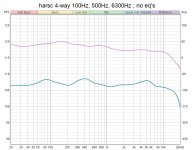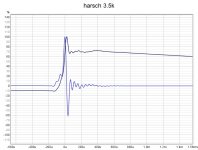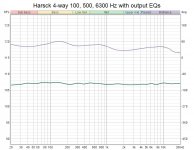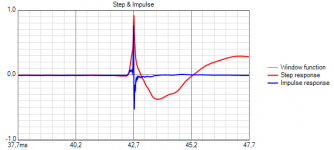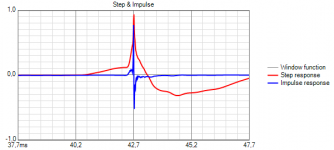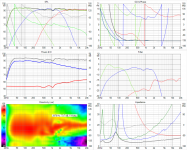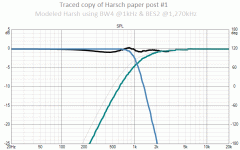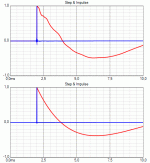is there any other Harsch type? i only know 1 type.@gadut
Depends on what type of multiway Harsch xo you want to use. If yo use BW4 slopes for all low-passes and BES2 slopes for all high-passes, then the starting point would be your lowest frequency driver and the next driver in frequency needs timing adjustment to that driver and so on to the rest.
woofer -> time adjusted midwoofer to woofer -> time adjusted midrange to midwoofer -> time adjusted tweeter to midrange
so you mean that each way delay is only affected by xo point rite, no need to accumulate the delay
Load your measurements to vituixcad, build your xover and adjust delay blocks and see in realtime what delays do and what delay is needed to get the response you try to achieve.
i have not done any measurement yet. my question related to delay value that should be entered on minidsp menu.
is there any other Harsch type? i only know 1 type.
so you mean that each way delay is only affected by xo point rite, no need to accumulate the delay
At the beginning of this thread there is a 3-way attempt from xrk which contains a BES2 bandpassed midrange, this is a "deviation" from the basic Harsch xo which is a BW4 low-pass and a BES2 high-pass.
In a multi-way speaker, the highest frequency driver needs to contain all the previous delays from the lower frequency driver(s) plus its own xo point delay.
At least if you use BW4 for all the low-passes and BES2 for all the high-passes.
But yeah, just simulate it as mentioned above.
the more I used delay (advance on the woofer relative to mid and tweeter) the more there was stuff on the left in the step response. I'd quess harsh xo trick works better with a two way setup than threeway since less delay is needed.
Mark100, does this harsh xo go well with your MEH? is there delay between woofer (taps) and tweeter so that no electrical delay is needed? Just came to my mind that MEHs have tweeters behind woofers so there might be some relation in this xo setup?
Hi Tmuikku, nice work btw 🙂
You read my mind, that's why i was looking at the Harsch...to see if it would go well with my latest MEH, that I call syn7.
Syn7 has acoustic centers with woofers behind the tweeter about 0.8ms.
By visual inspection this looks backwards since the woofer ports are closer to the mouth. But there is distance below the woofer ports to the cone, and somehow the tweeter (CD) measures with an apparent acoustic center out into the throat.
i guess none of that really matters because if i use a Harsch with the syn7, first xover is at 100Hz which needs a 5ms delay to all the upstream drivers, and that will continue to require digital delays in place.
I worked out a 4-way Harsch that i think will work nicely with xovers at 100, 500, and 6300 Hz....using the approach YSDR descibed in #724.
That gives delays of 6.08ms to VHF, 6.0 to HF, and 5.0 to mid, 0 to sub....just for the Harsch. Graphs are below.
So interestingly, the relative phase flattening provided by the Harsch comes with 6.08ms constant delay.
From experience, this is about half the constant delay needed to implement linear phase 4th order LR's at the same xover points, which gives basically ruler flat mag and phase.....at the expense of another 6ms latency.
In my mind it just shows no free lunch when it comes to phase.....my motto is becoming "it takes time to fix time" 😀
Anyway, I'm going to try the Harsch for when I want to use the syn7's for live sound with a traditional IIR processor.
Otherwise I'll stick with my FIR tuning. I just can't see it being beat.
When I met the Danley folks at a trade show, they said some customers had replaced their SH-50's passive xovers, moving to the same way i've been processing . So it's not just me lol.
Attachments
Interesting - my XO is 3500Hz and looks more like your 100Hz one. Maybe I did find a new XO filter slope?
Maybe you did ! Give it a cool name if you find out you did !
fwiw, here's what i got for a 2-way at 3.5 kHz.
They all vary a bit, huh?
Oh I should add, the processor that's generating these has a number of Bessel high pass options.
-3 dB mirror magnitude
-3 dB flat group delay
natural mirror magnitude
natural phase match
I've been using natural mirror magnitude, as its transfers simply look the best.
Maybe the options are only relevant when both sides are Bessel ?
Any advice ?
Attachments
Wow, that’s very cool Mark! I see the 4x 55deg rise bumps for each XO. Somehow it all manages to work out. 6ms less latency is a lot of time actually.
This looks extremely complicated to implement. Did you have the delays relative to one another? So that is one slides, the other 3 move with it?
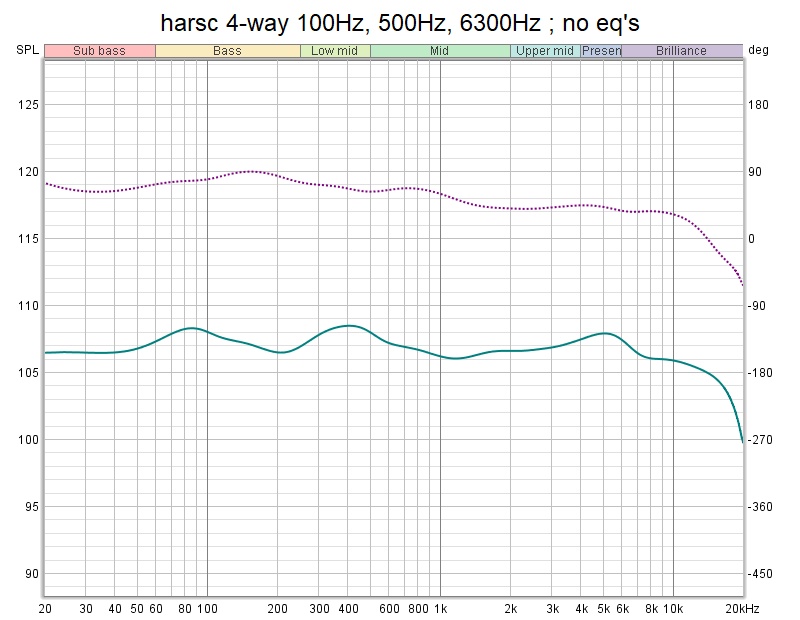
This looks extremely complicated to implement. Did you have the delays relative to one another? So that is one slides, the other 3 move with it?
I worked out a 4-way Harsch that i think will work nicely with xovers at 100, 500, and 6300 Hz....using the approach YSDR descibed in #724.
That gives delays of 6.08ms to VHF, 6.0 to HF, and 5.0 to mid, 0 to sub....just for the Harsch.
So interestingly, the relative phase flattening provided by the Harsch comes with 6.08ms constant delay.
Looks like you need to "physically" time align your sub then you would only have 1.08ms delay 🙂
Wow, that’s very cool Mark! I see the 4x 55deg rise bumps for each XO. Somehow it all manages to work out. 6ms less latency is a lot of time actually.
This looks extremely complicated to implement. Did you have the delays relative to one another? So that is one slides, the other 3 move with it?
Thx xrk !
Yes, I agree, a 6ms reduction in latency can be huge. Looks like an especially good technique for live sound stage monitors.
It's not at all difficult to implement.
Your first page instructions, and YSDR's multi-way instructions made it a snap. Built it in q-sys in 5-10min.
I do have to input xover frequencies and delays per output manually,
but that's just a matter of a couple of minutes per try. Which is easier than the time it would take to automate delays automatically falling in line. Could be done, but i think I'd have to learn Lua, which is custom control language for q-sys.
Here's a quick and nasty addition of a few 2-3 EQ's on each of the 4 outputs post xover. (Also removed a low-pass filter at 20kHz from prior post.)
Wanted to see how well minimum phase corrections appear to work before trying it on speaker.
Attachments
Looks like you need to "physically" time align your sub then you would only have 1.08ms delay 🙂
1.08ms would be super !
By physical time alignment, do you mean pulling the sub 5ms closer to listening position vs the syn7 position? And lose 1/4 WL coupling at 100Hz?
Or maybe you were just saying tongue-in-cheek 🙂 ?
I think those issues are why most all systems that need low latency, but want to use FIR tuning for mains where latency is not an issue, end up passing subs to mains with IIR.
I was both serious and tongue in cheek at the same time 😉
The big delay in your setup is between the sub and the mid so yes physically moving the sub would remove the need for the digital delay. Having them 1.72m apart might look a little weird?
As to the acoustic coupling at the crossover I can't say but if they are vertically aligned and only moved in or out then the physical distance is the same as time delay, you are changing the effective acoustic centre the same amount with both.
I think this can be got away with at 100Hz, especially with your steep crossovers but you would have to try it out to be sure.
The big delay in your setup is between the sub and the mid so yes physically moving the sub would remove the need for the digital delay. Having them 1.72m apart might look a little weird?
As to the acoustic coupling at the crossover I can't say but if they are vertically aligned and only moved in or out then the physical distance is the same as time delay, you are changing the effective acoustic centre the same amount with both.
I think this can be got away with at 100Hz, especially with your steep crossovers but you would have to try it out to be sure.
Hi, one more post about my observations of simulating this xo topology.
I really cannot get a sweet spot anywhere on vertical axis around mid frequencies with this crossover topology. The problem seems to be too long c-to-c spacing between 8" mid driver and high frequency horn (around 1 WL). Also there are some anomalies with the mid driver on the prototype enclosure, maybe diffraction issues or box resonances or something. These anomalies seem to get worse with interaction from both woofer and the horn and it is really difficult (feels impossible) to try and balance these out. The vertical response is kind of lob sided in general: a peak below vertical listening axis seems to have a dip above the axis and vice versa. Due to this frequency response changes dramatically when the listening height changes.
So I conclude this will not work well with a horn speaker where it is hard to get c-to-c spacing much closer than this. Or maybe it is just the weird mid driver response I have. Anyway, watch your vertical polars with the Harsch xo 😉 With more traditional xo I'm able to get pretty good and uniform frequency response at and around vertical listening axis, around 30 degrees total. I think this is better compromise than poor frequency response and "better" step response in my case.
So as mark100 stated this is not some secret sauce here. One needs speaker system that suits the Harsch xo topology to get something out from it. Better step response and less phase rotation could be achieved with a multiple entry horn for example, or just slapping a linear phase FIR 🙂
I really cannot get a sweet spot anywhere on vertical axis around mid frequencies with this crossover topology. The problem seems to be too long c-to-c spacing between 8" mid driver and high frequency horn (around 1 WL). Also there are some anomalies with the mid driver on the prototype enclosure, maybe diffraction issues or box resonances or something. These anomalies seem to get worse with interaction from both woofer and the horn and it is really difficult (feels impossible) to try and balance these out. The vertical response is kind of lob sided in general: a peak below vertical listening axis seems to have a dip above the axis and vice versa. Due to this frequency response changes dramatically when the listening height changes.
So I conclude this will not work well with a horn speaker where it is hard to get c-to-c spacing much closer than this. Or maybe it is just the weird mid driver response I have. Anyway, watch your vertical polars with the Harsch xo 😉 With more traditional xo I'm able to get pretty good and uniform frequency response at and around vertical listening axis, around 30 degrees total. I think this is better compromise than poor frequency response and "better" step response in my case.
So as mark100 stated this is not some secret sauce here. One needs speaker system that suits the Harsch xo topology to get something out from it. Better step response and less phase rotation could be achieved with a multiple entry horn for example, or just slapping a linear phase FIR 🙂
Hi tmuikku, think in general most whatever topology of XO slope give some lobe scheme in XO region because directivity nearly never are 100% same for the two summing passbands and also note XO slopes that are not in phase so as Harsch and 1st order will have a tilted lobe in XO region because of spacing distance between drivers and you need coxials arays to defeat lobe will tilt in XO region or use some XO slopes that are in phase.
A general note to all users of Harsh of what i learned is when you set a target frequency say 2kHz the low pass part is a textbook 2kHz 4th order butterworth but high pass 2nd order bessel part is not a textbook 2kHz target, we want the bessel textbook slope part to cross the textbook butterworth part at -4,2dB not at -3,0dB and below animation model show the error, so therefor its nessesary times bessel target with 1,27 number and then we gets a 2540Hz number, alternative to set a textbook bessel slope is use 2nd order Linkwitz Riley plus one PEQ +1,3dB Q0,58 or cascade 2 times 1st order butterworth to get the 2nd order Linkwitz Riley and if one use this reciep one can target same frequency as the low pass part so its not nessesary times or divide here.
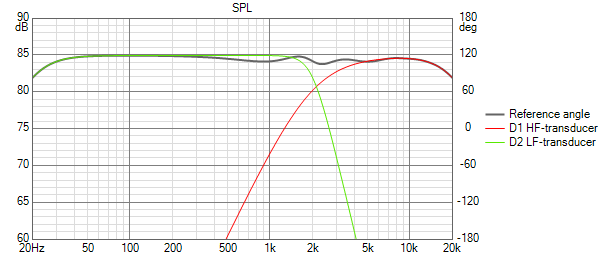
A dirty quick eyeball of your slopes tmuikku tell your not near the textbook ones, i could be wrong but if im right think you should consentrate set them right to hear what Harsch is about, as helper you can rightclick and load the 100% textbook targets as overlay in VituixCAD and they textbook slopes can be created in either VC itself or free Rephase, in below model you can see what the spacing distance means simulated using a homebrew textbook omni driver per passband that cover the 20Hz-20kHz audioband, summing response will change a bit because of the spacing distance and lobeing happen and the main lobe will tilt downward, and BTW 172mm spacing is one wavelenght, horizontals is omitted in animation simply because they perfect and not worth looking at or learning anything from 🙂..
(Click inside animation to get X/Y ratio and resolution right)
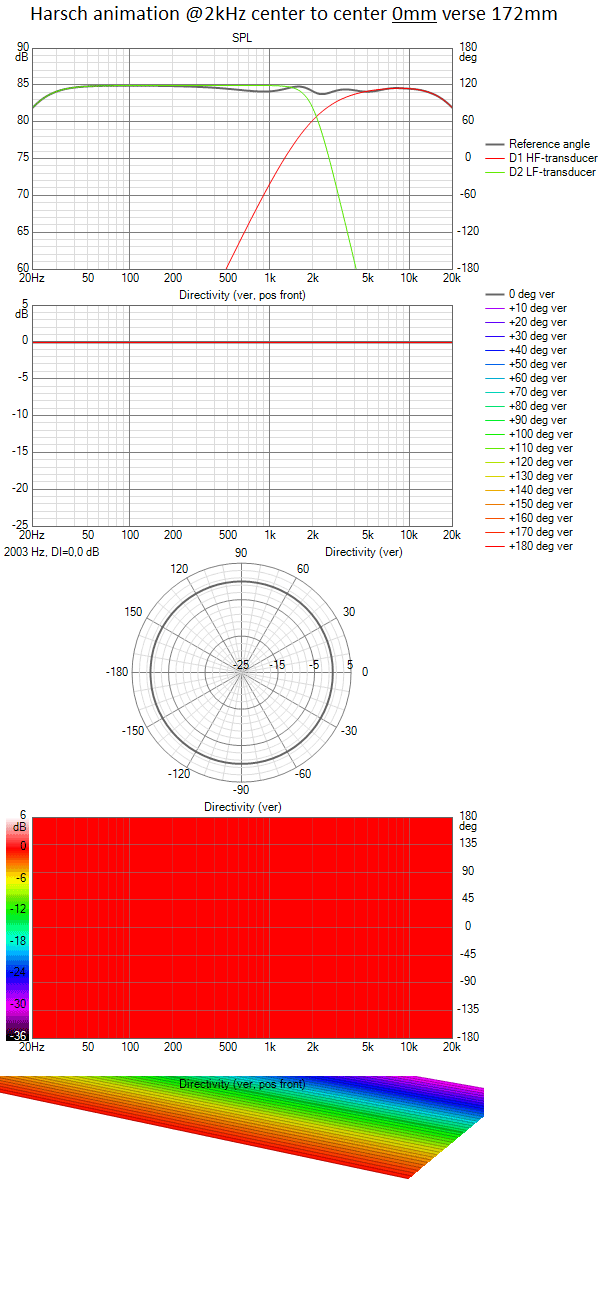
A general note to all users of Harsh of what i learned is when you set a target frequency say 2kHz the low pass part is a textbook 2kHz 4th order butterworth but high pass 2nd order bessel part is not a textbook 2kHz target, we want the bessel textbook slope part to cross the textbook butterworth part at -4,2dB not at -3,0dB and below animation model show the error, so therefor its nessesary times bessel target with 1,27 number and then we gets a 2540Hz number, alternative to set a textbook bessel slope is use 2nd order Linkwitz Riley plus one PEQ +1,3dB Q0,58 or cascade 2 times 1st order butterworth to get the 2nd order Linkwitz Riley and if one use this reciep one can target same frequency as the low pass part so its not nessesary times or divide here.
A dirty quick eyeball of your slopes tmuikku tell your not near the textbook ones, i could be wrong but if im right think you should consentrate set them right to hear what Harsch is about, as helper you can rightclick and load the 100% textbook targets as overlay in VituixCAD and they textbook slopes can be created in either VC itself or free Rephase, in below model you can see what the spacing distance means simulated using a homebrew textbook omni driver per passband that cover the 20Hz-20kHz audioband, summing response will change a bit because of the spacing distance and lobeing happen and the main lobe will tilt downward, and BTW 172mm spacing is one wavelenght, horizontals is omitted in animation simply because they perfect and not worth looking at or learning anything from 🙂..
(Click inside animation to get X/Y ratio and resolution right)
Attachments
Last edited:
Good to hear from you Byrtt - it's been much too long and I hope you are well in this new covid landscape. Thank you for the simulations and for pointing out the trick with the -4.2dB crossover point. I like your animations - so the black line represents what happens when one sums at -3dB vs -4.2dB?
Yeah thanks for your time BYRTT! Yep my slopes weren't spot on on the previous screenshots, but just checked the revision from last night happened to be pretty close the 2000Hz bw4 lowpass and 2,5k bessel highpass so thats about right 🙂
As you showed it has pretty severe lobing with one wavelength spacing, the actual is 165mm with 8" driver and Faital pro STH100 horn I've got. I could get the crossover point a bit lower. The lobing is already much better at 1/2 WL spacing. I shall load this configuration to my DSP and check out what's the fuss about 🙂 Attached is the best I could get.
Also, the lower crossover between woofer and mid can be something else to almost similar results. Step response loses the "pre" rise if I use no delay and just invert the woofer with Lowpass close to bessel 2nd order and high pass close to 2nd order butterworth. Another attachment is to illustrate this.
note: my previous step response images showed around 1ms of time after the initial peak whereas XRK and others have 4ms or more visible.
As you showed it has pretty severe lobing with one wavelength spacing, the actual is 165mm with 8" driver and Faital pro STH100 horn I've got. I could get the crossover point a bit lower. The lobing is already much better at 1/2 WL spacing. I shall load this configuration to my DSP and check out what's the fuss about 🙂 Attached is the best I could get.
Also, the lower crossover between woofer and mid can be something else to almost similar results. Step response loses the "pre" rise if I use no delay and just invert the woofer with Lowpass close to bessel 2nd order and high pass close to 2nd order butterworth. Another attachment is to illustrate this.
note: my previous step response images showed around 1ms of time after the initial peak whereas XRK and others have 4ms or more visible.
Attachments
Good to hear from you Byrtt - it's been much too long and I hope you are well in this new covid landscape. Thank you for the simulations and for pointing out the trick with the -4.2dB crossover point. I like your animations - so the black line represents what happens when one sums at -3dB vs -4.2dB?
Thanks X and same to you, my left foot is still a hell so have not time and energy be here so much and that way also stay natural away from the covid horror, and yes the black line is the sum and you can see it toggles a higher riple when tweeter slope toggle to bessel textbook @2kHz verse bessel textbook @2540Hz.
Now if you like animations here is another one that should be proof for case, i traced your published Harsch paper from post 1 that is missing resolution jn graphs spin because it step 5dB at a time so we cant really eyeball where slobes cross each other, its supposed to be target @1kHz XO and have overlaid a silver grey textbook curve BES2 @1kHz that clearly deviate from tweeter curve in that paper, then it toggles a modeled clean replica from VituixCAD using 1kHz for BW4 and 1,27kHz for BES2 and tweeter is delayed the nessesary 500uS in model, it looks them two is close when we count for deviation trace a relative low resolution paper and its looking 100% clear that the textbook BES2 @1kHz is wrong here.
Attachments
Last edited:
+1 🙂Good to hear from you Byrtt - it's been much too long and I hope you are well in this new covid landscape.
Yeah thanks for your time BYRTT! Yep my slopes weren't spot on on the previous screenshots, but just checked the revision from last night happened to be pretty close the 2000Hz bw4 lowpass and 2,5k bessel highpass so thats about right 🙂
As you showed it has pretty severe lobing with one wavelength spacing, the actual is 165mm with 8" driver and Faital pro STH100 horn I've got. I could get the crossover point a bit lower. The lobing is already much better at 1/2 WL spacing. I shall load this configuration to my DSP and check out what's the fuss about 🙂 Attached is the best I could get.
Also, the lower crossover between woofer and mid can be something else to almost similar results. Step response loses the "pre" rise if I use no delay and just invert the woofer with Lowpass close to bessel 2nd order and high pass close to 2nd order butterworth. Another attachment is to illustrate this.....
Welcome, come to think about if your DSP can do FIR then it wont cost much propagation delay use FIR filter from mid to horn tweeter and run Harsch from woofer to mid, that said allpass delay of minimum phase filters when they target 2kHz and up is difficult to hear for most and below 1kHz its easy for many.
.....note: my previous step response images showed around 1ms of time after the initial peak whereas XRK and others have 4ms or more visible.
Think this one can have many reasons, one is it can be the other users curves have tons of room gain or reflections involved compared to yours, other is you own curve are too filtered using gating or frequency dependant window is some, if i take your first plot and trace it into VC i get a steep 6th order BW roll off @33Hz and that is about a 2mS step so your 1mS step is too short compared the curve and also we can see in your lower left polar map that there is not much red color down there where directivity normal is 360º around, in below animation the upper one is your traced curved and the lower one toggle textbook a @33Hz roll off of 9/5/7/3/2 orders and somewhere around 3rd and 2nd order it reach 4mS..
Attachments
Last edited:
Good to hear from you Byrtt - it's been much too long and I hope you are well in this new covid landscape..
+1 🙂
@BYRTT, we sure are glad to see you here again 🙂. I hope your health situation improves soon!
Many thanks warm wishes guys, health will fortunate improve soon but probably im so behind in life and diyA that it will take some time be really back here, heck i bought some KEF Q150 months ago (recieved in april) and i havent had time and energy hear them yet before their new journey where coxial arrays will get canabilized to build some diy stuff.
cheers and have a best day.
Last edited:
- Home
- Loudspeakers
- Multi-Way
- S. Harsch XO

